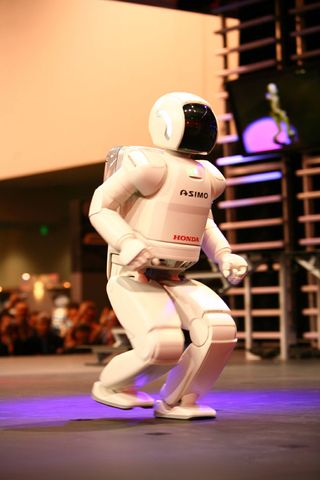The Secret to More Useful Robots: Tai Chi Training

The dream of helpful household robots is one that's been long deferred. Problem is, robots tend to be clumsy.
So train them in tai chi, researchers suggest.
More graceful robots could better handle boring household chores that require smooth, coordinated movements, just like the robotic maid Rosey helped the cartoon TV-series Jetsons dust tables, clean windows and vacuum floors.
When humans perform tasks, they often assume postures that minimize discomfort and effort. For instance, when taking a sip from a hot cup of coffee, most people naturally hold their forearm at about a 45-degree angle, not up near their ear or down by their side. Humans start learning which movements and positions to use and avoid from infancy.
The 7-year-old humanoid robot ASIMO made by Honda can walk, run and greets passersby. However, it cannot yet perform useful tasks in a complex world in real time as humans can. The Roomba floor vacuum does a great job cleaning floors. But its efficiency owes to it's lack of limbs and singular objective. Humans wait for more help around the house.
To get robots to perform multiple tasks smoothly and simultaneously, roboticist Oussama Khatib at the Stanford Artificial Intelligence Laboratory in California and his colleagues wanted to see if machines could employ the same energy minimization strategy humans learn.
"We want to create robots that can work with humans, so we wanted robots to learn how humans move and interact with the world, which led us to go and try to better understand how humans move," Khatib told LiveScience.
Sign up for the Live Science daily newsletter now
Get the world’s most fascinating discoveries delivered straight to your inbox.
The researchers investigated how people move by using sensors to follow human volunteers such as Khatib's students and a tai chi master visiting from China as they performed movements such as bending, walking and jumping.
"The tai chi master helps provide data on motions that are closer to optimal in performance for comparison," Khatib said.
Using this data, the scientists devised computer models that showed how people minimize effort. These allow robots to perform tasks without computing where exactly it will go in advance as conventional methods do, saving on the number of computations the robots have to carry out.
So far the researchers are testing their effort minimization models with StanBot, a robot that now "lives" solely in computers as a simulation. In about a year, Khatib hopes to see his software embodied in ASIMO, to help it one day be able to perform chores such as ironing and clearing tables.
"All of this is going to give ASIMO new capabilities to have advanced behavior like a human and to interact with the world," Khatib said.
The researchers are also exploring how humans constrain their motions to, for instance, keep from inadvertently colliding with obstacles or damaging fragile objects. "This will help extend dexterity to robots," Khatib added.
- All About Robots
- Vote For Your Favorite Real Robots
- Image Gallery: Cutting Edge Robots

